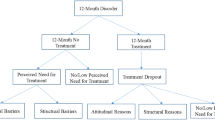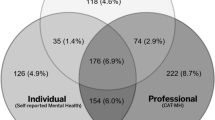Abstract
This study examined barriers to seeking mental health care reported by individuals in a rural impoverished population, by screening 646 randomly selected adults for depression, anxiety, and alcohol abuse. Respondents who screened positive were randomly assigned to one of three groups: (1) no intervention, (2) an educational intervention alone, or (3) the educational intervention in the presence of a significant other. Those who screened positive for disorders cited barriers to care at significantly higher rates than respondents who screened negative. Respondents who received the educational intervention endorsed several barriers at significantly lower rates in the follow-up telephone call (subsequent to the intervention) than in the original interview (prior to the intervention). Virtually all respondents in a subsample of 142 subjects (99.3%) said they would seek mental health care if they thought mental health services would help them.
Similar content being viewed by others
References
Beeson, P. G., Britain, C., Howell, M. L., Kirwan, D., & Sawyer, D. A. (1998). Rural mental health at the millennium. In R. W. Manderscheid & M. J. Henderson (Eds.), Mental Health, United States, 1998 (DHHS Pub. No. (SMA)99–3285, pp. 82–97). Center for Mental Health Services. Washington, DC: Supt. of Documents, U. S. Government Printing Office.
Fox, J. C., Blank, M., Berman, J., & Rovnyak, V.G. (1999). Mental disorders and help seeking in a rural impoverished population. International Journal of Psychiatry in Medicine, 29, 181–195.
Fox, J., Merwin, E., & Blank, M. (1995). Defacto mental health services in the rural south. Journal of Health Care for the Poor and Underserved, 6, 434–68.
Gallo, J.J., Marino, S., Ford, D., & Anthony, J.C., (1995). Filters on the pathway to mental health care, II. Sociodemographic factors. Psychological Medicine, 25, 1149–60.
Hill, C. E. (1988). Community health systems in the rural American South: Linking people and policy. Boulder, CO: Westview Press.
Hill, C. E. (1996). Mental health decision modeling in rural Virginia. Presented at the American Anthropological Association meeting, San Francisco.
Horgan, C. M. (1985). Specialty and general ambulatory mental health services: Comparison of utilization and expenditures. Archives of General Pyschiatry, 42, 565–572.
Kessler, R. C., McGonagle, K. A., Zhao, S., Nelson, C. B., Hughes, M., Eshleman, S., Wittchen, H.-U., & Kendler, K. S. (1994). Lifetime and 12–month prevalence of DSM-III-R psychiatric disorders in the United States. Results from the National Comorbidity Survey. Archives of General Psychiatry, 51, 8–19.
Link, B. G., Mirotznik, J., & Cullen, F. T. (1991). The effectiveness of stigma coping orientations: Can negative consequences of mental illness labeling be avoided? Journal of Health & Social Behavior, 32, 302–320.
Link, B. G., & Phelan, J. C. (1996). Editorial: Understanding sociodemographic differences in health–The role of fundamental causes. American Journal of Public Health, 86, 471–473.
Lynch, J. W. (1996). Social position and health. Annals of Epidemiology, 6, 21–23.
Lynch, J. W., Kaplan, G. A., & Salonen, J. T. (1997). Why do poor people behave poorly? Variation in adult health behaviours and psychosocial characteristics by stages of the socioeconomic lifecourse. Social Science and Medicine, 44, 809–819.
Lynch, J. W., Kaplan, G. A., & Shema, S. J. (1997). Cumulative impact of sustained economic hardship on physical, cognitive, psychological, and social functioning. New England Journal of Medicine, 337, 1889–1895.
Manning, W. G., Jr., & Wells, K. B. (1986). Preliminary results of a controlled trial of the effect of a prepaid group practice on the outpatient use of mental health services. Journal of Human Resources, 21, 293–320.
Muehrer, P. (1997). Introduction to the special issue: Mental health prevention science in rural communities and contexts. American Journal of Community Psychology, 25, 421–424.
Narrow, W. E., Regier, D. A., Rae, D. S., Manderscheid, R. W., & Locke, B. Z. (1993). Use of services by persons with mental and addictive disorders. Archives of General Psychiatry, 50, 95–107.
Neighbors, H. W., & Jackson, J. S. (1984). The use of informal and formal help: Four patterns of illness behavior in the black community. American Journal of Community Psychology, 12, 629–644.
Pescosolido, B. A., Gardner, C. B., & Lubell, K. M., (1998). How people get into mental health services: Stories of choice, coercion, and “muddling through” from “first-timers. ” Social Science and Medicine, 46, 275–286.
Plackett, R.L. (1971). An Introduction to the Theory of Statistics. New York: Barnes & Noble, 1971: 185–187.
Regier, D.A., Farmer, M.E., Rae, D.S., Myers, J.K., Kramer, M., Robins, L.N., George, L.K., Karno, M., & Locke, B.Z. (1993). One-month prevalence of mental disorders in the United States and sociodemographic characteristics: the Epidemiologic Catchment Area study. Acta Psychiatrica Scandinavica, 88, 35–47.
Sartorius, N. (1997). Psychiatry in the framework of primary health care: A threat or boost to psychiatry? American Journal of Psychiatry, 154(6), 67–72.
Sussman, L.K., Robins, L.N., & Earls, F. (1987). Treatment-seeking for depression by black and white Americans. Social Science & Medicine, 24, 187–196.
U.S. Bureau of the Census. (1992). Census of Population and Housing, 1990: Summary Tape File 3 on CD-ROM Technical Documentation. Washington: The Bureau of the Census.
U.S. Census Bureau. Median Household Income 1990. http//venus.census.gov/cerom/lookup/>(accessed 5 June 1997).
World Health Organization (1990). Composite International Diagnostic Interview. Geneva, Switzerland: WHO.
Yuen, E. J., Gerdes, J. L., & Gonzales, J. J. (1996). Patterns of rural mental health care: An exploratory study. General Hospital Psychiatry, 18, 14–21.
Author information
Authors and Affiliations
Rights and permissions
About this article
Cite this article
Fox, J.C., Blank, M., Rovnyak, V.G. et al. Barriers to Help Seeking for Mental Disorders in a Rural Impoverished Population. Community Ment Health J 37, 421–436 (2001). https://doi.org/10.1023/A:1017580013197
Issue Date:
DOI: https://doi.org/10.1023/A:1017580013197




